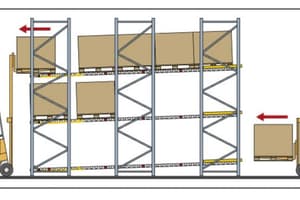Podcast
Questions and Answers
What are the key materials commonly used in pallet construction, and how do they impact the design?
What are the key materials commonly used in pallet construction, and how do they impact the design?
Key materials include wood, plastic, metal, and corrugated paper, which impact durability, weight, and cost.
Explain the significance of standard dimensions in pallet design.
Explain the significance of standard dimensions in pallet design.
Standard dimensions, like 48” x 40” for grocery pallets, ensure compatibility with handling equipment and facilitate transportation across various modes.
How can structural integrity be maintained in pallet design?
How can structural integrity be maintained in pallet design?
Structural integrity can be maintained by ensuring proper load distribution and incorporating necessary reinforcements to prevent collapse.
What role does sustainability play in pallet design principles?
What role does sustainability play in pallet design principles?
Why is cost-effectiveness a critical principle in pallet design?
Why is cost-effectiveness a critical principle in pallet design?
Flashcards are hidden until you start studying
Study Notes
Pallet Design Principles
-
Functionality:
- Must support the weight and dimensions of goods.
- Should facilitate easy handling and transportation.
-
Material Selection:
- Common materials include wood, plastic, metal, and corrugated paper.
- Material choice impacts durability, weight, and cost.
-
Dimensions and Standards:
- Standard sizes (e.g., 48” x 40” for grocery, 42” x 42” for automotive).
- Design should accommodate various goods and transportation methods.
-
Structural Integrity:
- Design must ensure stability and prevent collapse during stacking.
- Consider load distribution and reinforcement as needed.
-
Ease of Use:
- Should allow for easy loading and unloading with forklifts or pallet jacks.
- Design for user-friendly handling to minimize injury risks.
-
Sustainability:
- Preference for recyclable or biodegradable materials.
- Design should consider life cycle and end-of-life options.
-
Interoperability:
- Must work with existing handling equipment and storage systems.
- Consider compatibility with different transport modes (e.g., trucks, ships).
-
Cost-Effectiveness:
- Design should balance quality, durability, and production costs.
- Aim for a low total cost of ownership through efficient design.
-
Safety:
- Ensure design minimizes sharp edges and other hazards.
- Should comply with safety regulations and standards in the industry.
These principles guide the effective design of pallets for home consolidation features, ensuring efficiency in storage and transportation of goods.
Pallet Design Principles
-
Functionality:
- Designed to support the specific weight and dimensions of various goods.
- Aims to facilitate the efficient handling and transportation of items.
-
Material Selection:
- Common materials include wood, plastic, metal, and corrugated paper.
- Selection impacts durability, overall weight, and cost-effectiveness of the pallet.
-
Dimensions and Standards:
- Standard sizes: typically 48” x 40” for grocery items, and 42” x 42” for automotive applications.
- Essential for accommodating a variety of goods and compatible transportation methods.
-
Structural Integrity:
- Must ensure stability to prevent collapse when stacked.
- Consideration of load distribution and potential reinforcement techniques is critical.
-
Ease of Use:
- Designed for compatibility with forklifts and pallet jacks to promote easy loading/unloading.
- Focuses on user-friendly handling to reduce risk of injuries.
-
Sustainability:
- Emphasis on recyclable or biodegradable materials.
- Life cycle and end-of-life disposal options must be factored into design choices.
-
Interoperability:
- Should seamlessly integrate with existing handling equipment and storage systems.
- Must be compatible with diverse transport methods such as trucks and ships.
-
Cost-Effectiveness:
- Aims to balance product quality, durability, and production costs.
- Focused on achieving a low total cost of ownership through effective design choices.
-
Safety:
- Design must minimize sharp edges and other potential hazards.
- Compliance with industry safety regulations and standards is essential for all designs.
Studying That Suits You
Use AI to generate personalized quizzes and flashcards to suit your learning preferences.



